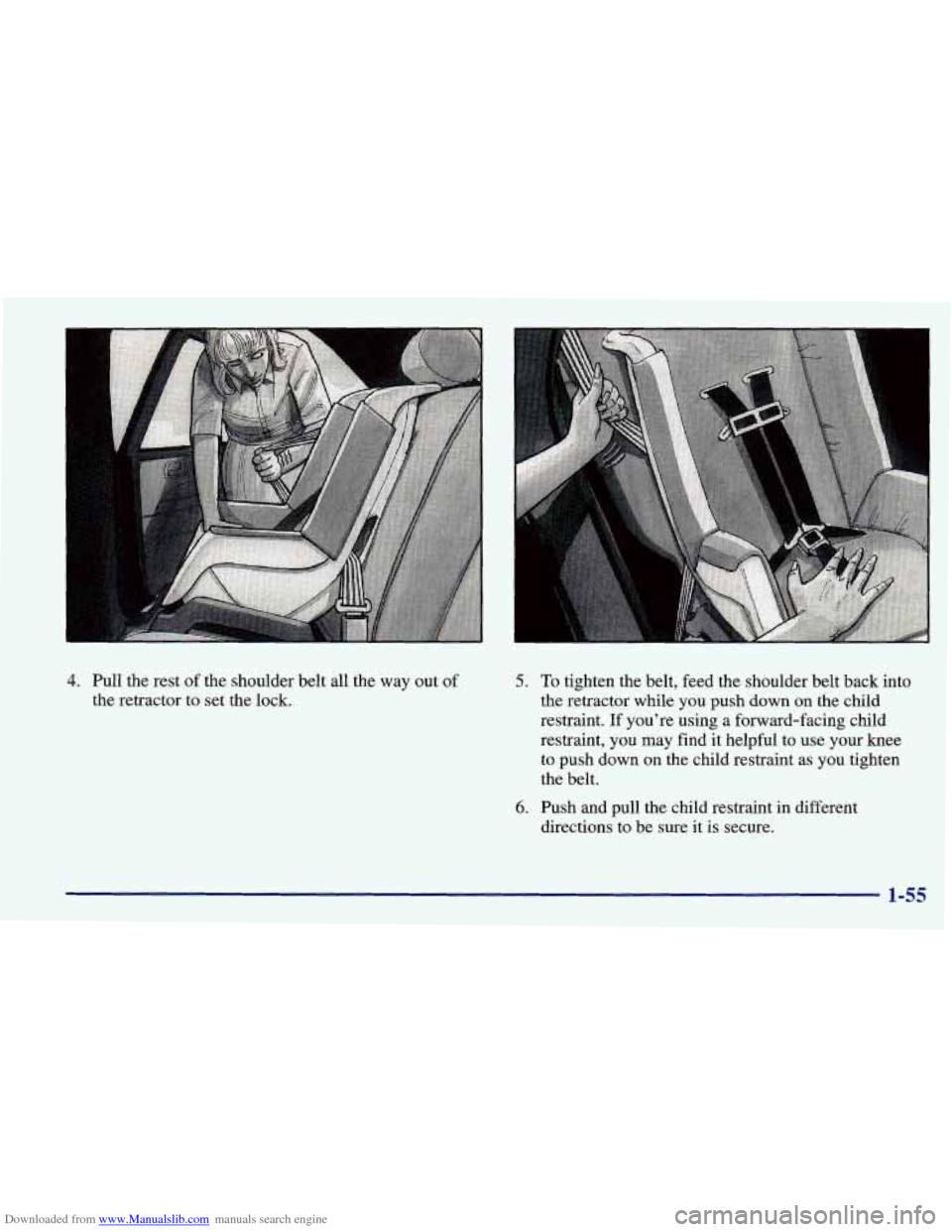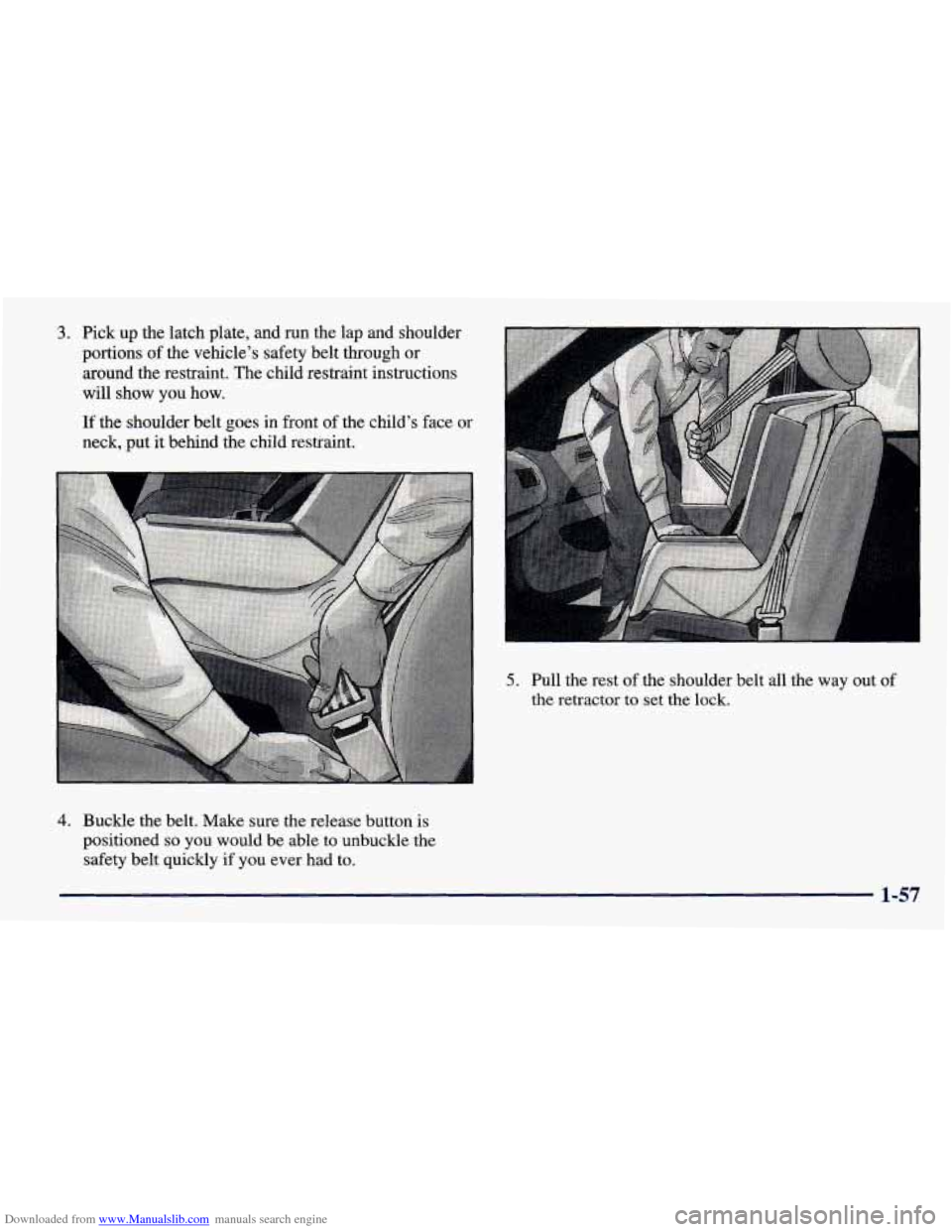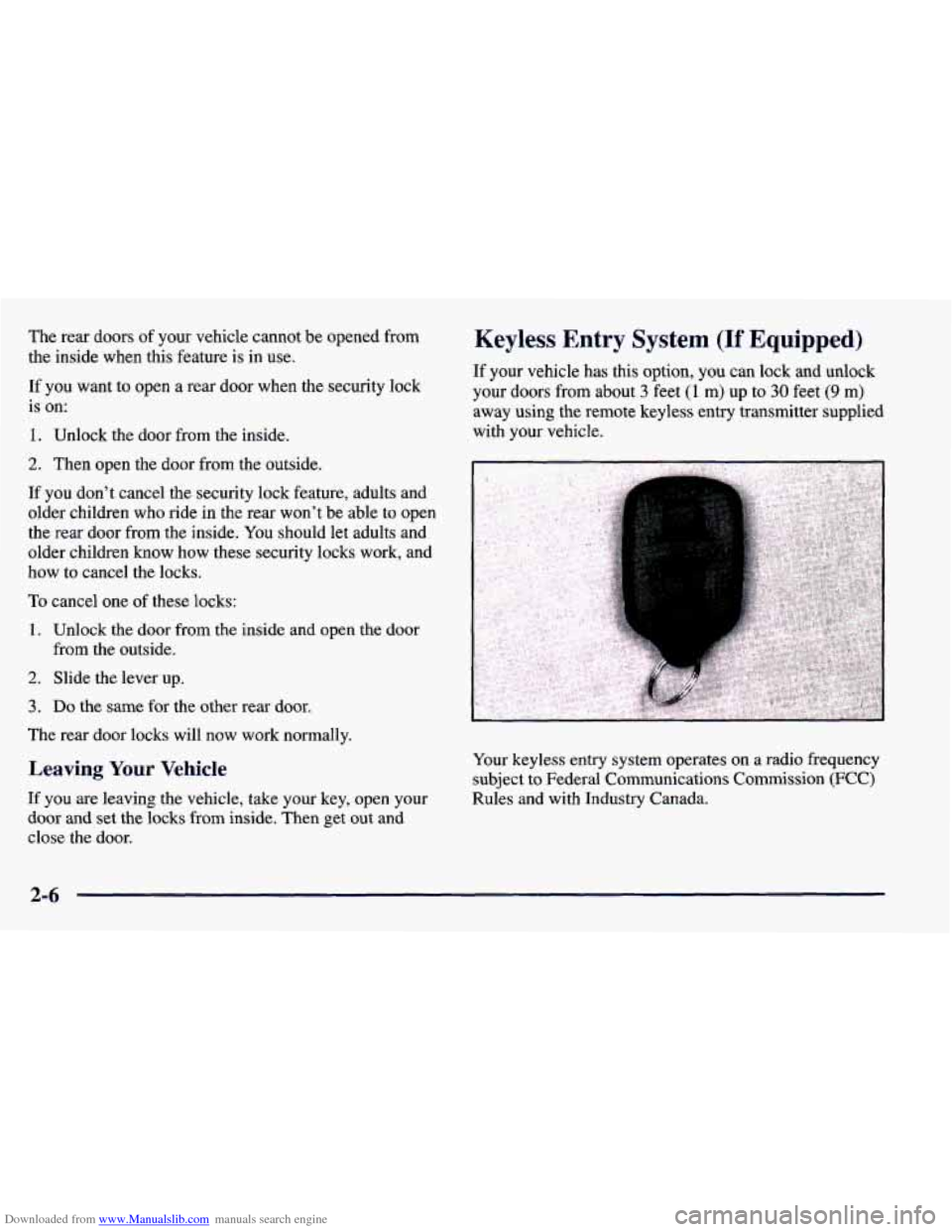1998 CHEVROLET PRIZM child lock
[x] Cancel search: child lockPage 27 of 364

Downloaded from www.Manualslib.com manuals search engine How to Wear Safety Belts Properly
Adults
This part is only for people of adult size.
Be aware that there are special things to know about
safety belts and children. And there
are different
rules for smaller children and babies. If a child will
be riding in your vehicle, see the part
of this
manual called “Children.” Follow those rules for
everyone’s protection.
First, you’ll want to know which restraint systems
your vehicle has.
We’ll start with the driver position.
Driver Position
This part describes the driver’s restraint system.
Lap-Shoulder Belt
The driver has a lap-shoulder belt. Here’s how to
wear it properly.
1. Close and lock the door.
2. Adjust the seat (to see how, see “Seats” in the
Index)
so you can sit up straight.
I
3. Pick up the latch plate and pull the belt across you.
Don’t let it get twisted.
The shoulder belt may lock if you pull the belt across
you very quickly. If this happens, let the belt go back
slightly to unlock it. Then pull the belt across you
more slowly.
4. Push the latch plate into the buckle until it clicks.
Pull
up on the latch plate to make sure it is secure.
If the belt isn’t long enough, see “Safety Belt
Extender” at the end
of this section.
1-13
Page 35 of 364

Downloaded from www.Manualslib.com manuals search engine The best way to protect the fetus is to protect the
mother. When a safety belt is worn properly, it’s more
likely that the fetus won’t be hurt
in a crash. For
pregnant women, as for anyone, the key to making
safety belts effective is wearing them properly.
Right Front Passenger Positi(- -I
To learn how to wear the right front passenger’s
safety belt properly, see “Driver Position” earlier in
this section.
The right front passenger’s safety belt works the same
way as the driver’s safety belt
-- except for one thing. If
you ever pull the shoulder portion of the belt out all the
way,
you will engage the child restraint locking feature.
If this happens, just let the belt
go back all the way and
start again.
Air Bag Systems
This part explains the frontal and side impact air
bag systems.
Your vehicle has air bags
-- a “Next Generation”
reduced-force frontal air bag for
the driver and another
“Next Generation” reduced-force frontal air bag for the
right front passenger. Reduced-force frontal air bags are designed
to help reduce the risk of injury from the force
of an inflating frontal air bag. But even these air bags
must inflate
very quickly if they are to do their job and
comply with federal regulations. Your vehicle may also
have side impact air bags
-- a side impact air bag for the
driver and another side impact air bag for the right
front passenger.
If your vehicle has side impact air bags, it will say
SRS
- SIDE AIRBAG on a label on the side of the
driver’s and right front passenger’s seat closest to
the door.
1-21
Page 69 of 364

Downloaded from www.Manualslib.com manuals search engine 4. Pull the rest of the shoufder belt all the way out of
the retractor to set the lock. 5.
6.
To tighten the belt, feed the shoulder belt back into
the retractor while
you push down on the child
restraint. If you’re using a forward-facing child
restraint, you may find it helpful to use your knee
to push down on the child restraint as you tighten
the belt.
Push
and pull the child restraint in different
directions to be sure it is secure.
1-55
Page 71 of 364

Downloaded from www.Manualslib.com manuals search engine 3. Pick up the latch plate, and run the lap and shoulder
portions of the vehicle’s safety belt through or
around the restraint. The child restraint instructions
will show you how.
If the shoulder belt goes in front of the child’s face or
neck, put it behind the child restraint.
5. Pull the rest of the shoulder belt all the way out of
the retractor to set the
lock.
4. Buckle the belt. Make sure the release button is
positioned so you would be able to unbuckle the
safety belt quickly if you ever had to.
1-57
Page 82 of 364

Downloaded from www.Manualslib.com manuals search engine Door Locks
Irn
Unlocked doors can be dangerous.
Passengers
-- especially children -- can easily
open the doors and fall out. When a door is
locked, the inside handle won’t open it.
Outsiders can easily enter through an unlocked
door when
you slow down or stop your vehicle.
This may not be
so obvious: You increase the
chance of being thrown out of the vehicle in a
crash if the doors aren’t locked. Wear safety belts
properly, lock your doors, and you will be
far
better off whenever you drive your vehicle.
Insert the key in either front door and turn the key
toward the rear
of the car to unlock the door.
If your vehicle has power door locks, turn the key once
to unlock the driver’s door only. Turn the key back
toward
the center, then toward the rear again to unlock
all the
doors. Using the key in the passenger’s door will
unlock all the doors.
To lock the door from the
inside, push down the
button on the door.
There are several ways
to lock and unlock your vehicle.
From the outside, use your key. To lock the door, turn
the key toward the front of the car. If you have power
door locks, all the doors will lock.
To unlock the door, pull up on the button.
2-4
Page 84 of 364

Downloaded from www.Manualslib.com manuals search engine The rear doors of your vehicle cannot be opened from
the inside when this feature
is in use.
If you want to open a rear door when the security lock
is on:
1. Unlock the door from the inside.
2. Then open the door from the outside.
If you don’t cancel the security lock feature, adults and
older children who ride in the rear won’t be able to open
the rear door from the inside. You should let adults and
older children know how these security locks work, and
how to cancel the locks.
To cancel one of these locks:
1. Unlock the door from the inside and open the door
from the outside.
2. Slide the lever up.
3. Do the same for the other rear door.
The rear door locks will now work normally.
Leaving Your Vehicle
If you are leaving the vehicle, take your key, open your
door and set the locks from inside. Then get out and
close the door.
Keyless Entry System (If Equipped)
If your vehicle has this option, you can lock and unlock
your doors from about
3 feet (1 m) up to 30 feet (9 m)
away using the remote keyless entry transmitter supplied
with your vehicle.
Your keyless entry system operates on a radio frequency
subject
to Federal Communications Commission (FCC)
Rules and with Industry Canada.
2-6
Page 163 of 364

Downloaded from www.Manualslib.com manuals search engine Steering in Emergencies
There are times when steering can be more effective
than braking. For example, you come over a hill and
find a truck stopped in your lane, or a car suddenly pulls
out from nowhere, or a child darts out from between
parked cars and stops right in front
of you. You can
avoid these problems by braking
-- if you can stop in
time. But sometimes you can’t; there isn’t room.
That’s the time for evasive action
-- steering around
the problem.
Your vehicle can perform very well in emergencies like
these. First apply your brakes
-- but, unless you have
anti-lock, not enough to lock your wheels. (See
“Braking in Emergencies” earlier in this section.) It is
better to remove as much speed as you can from a
possible collision. Then steer around the problem,
to
the left or right depending on the space available. An emergency
like this requires close attention and a
quick decision. If you are holding the steering wheel at
the recommended 9 and 3 o’clock positions, you can
turn it a full
180 degrees very quickly without removing
either hand. But you have to act fast, steer quickly, and
just as quickly straighten the wheel once you have
avoided the object.
The fact that such emergency situations are always
possible is a good reason to practice defensive driving
at all times and wear safety belts properly.
4-11
Page 350 of 364

Downloaded from www.Manualslib.com manuals search engine Brakes. Anti-Lock ............................... 4-7
Braking in Emergencies
........................... 4-9
Break-In. New Vehicle
.......................... 2-11
Built-In Child Restraint
.......................... 1-36
Cleaning
.................................... 6-47
Removing the Child
........................... 1-44
Securing a Child
.............................. 1-37
Bulb Replacement
.............................. 6-33
........................................ Brdcing 4-6
BTSI
.................................... 2-22. 7-40
BTSICheck
................................... 7-40
..................................... Storing 1-45
Canadian Roadside Assistance
.................... 8-7
Capacities and Specifications
...................... 6-59
Carbon Monoxide
................ 2.9.2.24.4.27. 4.33
Cassette Deck Service
........................... 7-37
Cassette Tape Player
............................. 3-8
Cassette Tape Player Care ........................ 3- 15
Certification Label
.............................. 4-29
Chains. Tire
................................... 6-44
Changing a Hat Tire
............................. 5-23
Charging System Light
.......................... 2-46
Check Engine Light
............................. 2-49
Checking
Your Restraint Systems .................. 1-61
Chemical Paint Spotting
.......................... 6-51
Child Restraints
............ 1.33.1.36.1.48.1.54. 1.56
Securing in the Rear Seat
Position ................ 1-54
Securing
in the Right Front Seat Position .......... 1-56
Top Strap .................................. , . 1-53
Cigarette Lighter
............................... 2-38
Built-In
....,............................... l-36
Wheretoput ................................ l-53
Circuit Breakers and Fuses ....................... 6-54
Cleaning Cleaner. Air .............................. 6.16. 6.60
Aluminum Wheels
............................ 6-49
Built-in Child Restraint
........................ 6-47
Exterior LampsLenses
........................ 6-48
Glass Surfaces
............................... 6-47
Inside
of Your Vehicle ......................... 6-45
Instrument Panel
............................. 6-46
Interior Plastic Components
..................... 6-47
Outside
of Your Vehicle ........................ 6-48 .
Special Problems ............................. 6-46
Windshield and Wiper Blades
................... 6-48
Climate Control System
........................... 3-2
Clock, Setting the
................................ 3-6
Clutch Adjustment
.............................. 6-22
Clutch, Hydraulic
............................... 6-22
Column, Tilt
................................... 2-26
Comfort Controls
................................ 3-2
Fabric
...................................... 6-45
...................................... Stains 6-46
Tires
....................................... 6-50
Vinyl 6-46 .......................................
Compact Disc
Care
....................................... 3-17
Player 3-11 ......................................
Player Care .................................. 3-17
Compact Spare Tire
............................. 5-33
Console Storage Area
........................... 2-37
Control
of a Vehicle .............................. 4-6
Convex Outside Mirror
.......................... 2-36
Recovery
Tank .......................... 5-16, 5-17
Coolant ....................................... 6-23
9-2